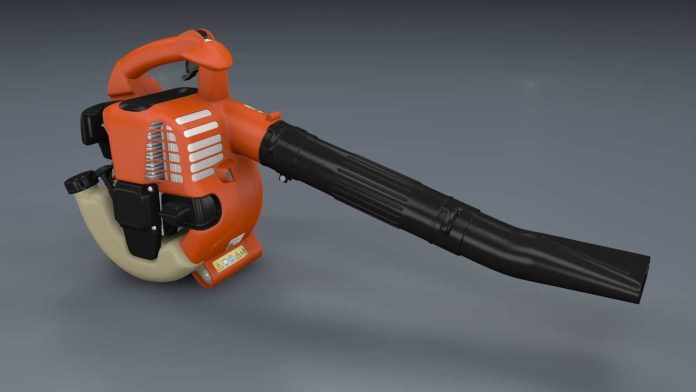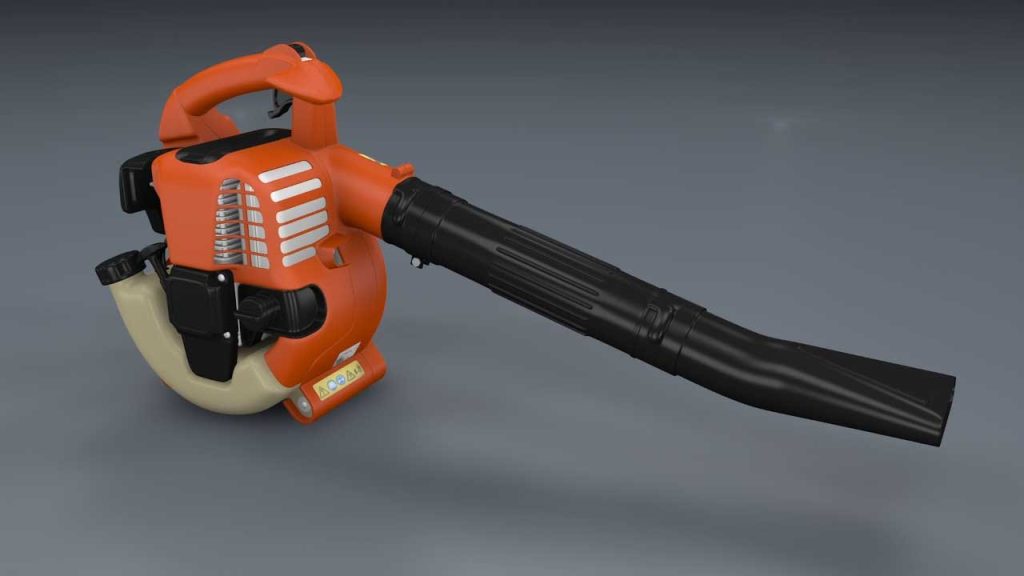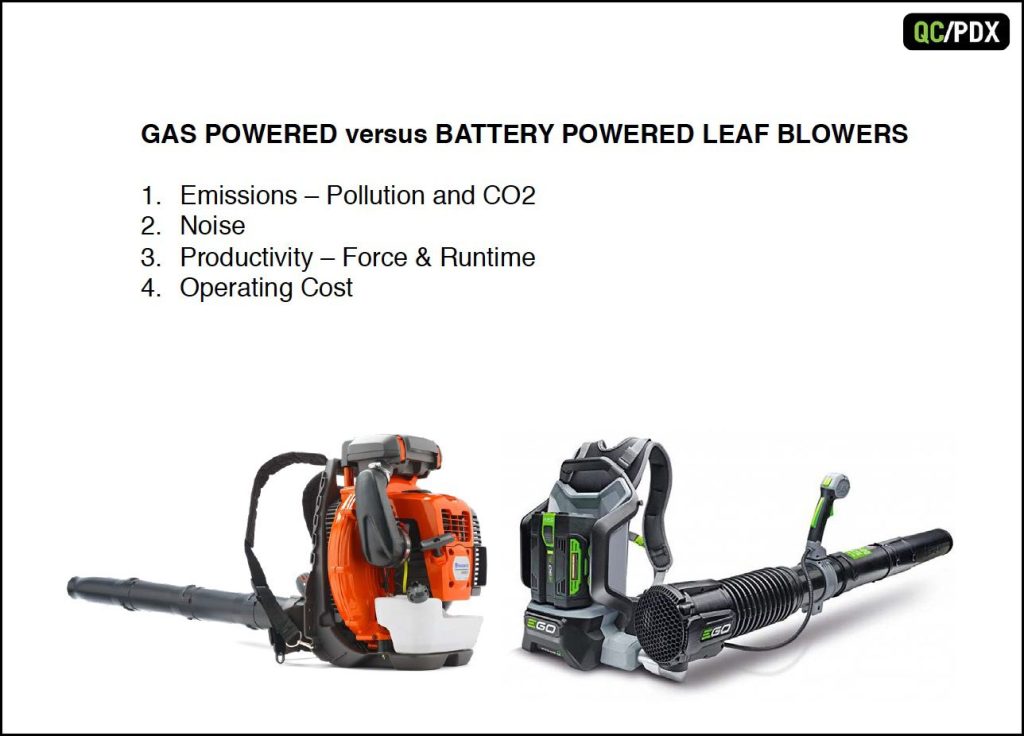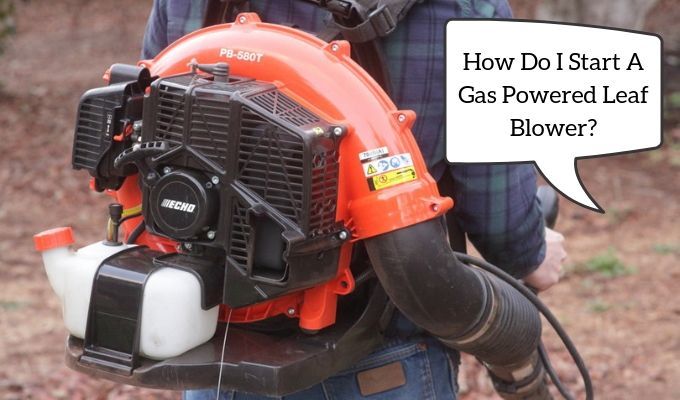Gas-powered leaf blowers are a marvel of engineering that makes cleaning up yard debris a breeze.
These powerful machines rely on a complex combination of air, fuel, and combustion to create a strong gust of air that can propel leaves, grass clippings, and other lightweight materials with ease.
In this article, we will delve into the inner workings of gas-powered leaf blowers and explain the fascinating process behind their efficient operation.
So, let’s unravel the mystery and discover how these handy devices get the job done!
1. Overview of gas-powered leaf blowers
Gas-powered leaf blowers are powerful outdoor tools for clearing leaves, grass clippings, and other debris from yards, sidewalks, and driveways. They provide an efficient way to manage and tidy up outdoor spaces. In this article, we will explore the components and working principle of gas-powered leaf blowers, their advantages and disadvantages, safety precautions, maintenance tips, and alternatives to consider.
1.1 Definition and Purpose
A gas-powered leaf blower is a machine that uses a gasoline-powered engine to generate a high-speed jet of air. The blower’s air jet is used to blow away leaves, grass, and other debris from outdoor areas. The purpose of a gas-powered leaf blower is to quickly and effectively clear outdoor spaces, saving time and effort compared to using manual tools like rakes.
1.2 Common applications
Gas-powered leaf blowers are commonly used for various outdoor applications. They are handy for removing fallen leaves during autumn, clearing grass clippings after mowing, and maintaining cleanliness in gardens, parks, and commercial landscapes. These blowers can also remove light snow from driveways and pathways.
1.3 Environmental concerns
While gas-powered leaf blowers offer convenience and power, they also raise concerns about their environmental impact. The combustion of gasoline in the engine releases carbon monoxide and other pollutants into the air, contributing to air pollution and greenhouse gas emissions. Additionally, the noise generated by gas blowers can cause noise pollution, disrupting the peace of neighborhoods. Considering these environmental concerns and exploring alternative options for leaf debris management is essential.
2. Components of a gas-powered leaf blower
Gas-powered leaf blowers have various components working together to deliver efficient blowing performance. Understanding these components is essential for proper maintenance and operation of the blower.
2.1 Engine
The engine is the heart of a gas-powered leaf blower. It is typically a two-stroke or four-stroke internal combustion engine that provides the power to drive the blower’s impeller. The engine determines the performance and efficiency of the blower.
2.2 Fuel system
The fuel system of a gas-powered leaf blower includes the fuel tank, fuel lines, and carburetor. The fuel tank holds the gasoline, which is then transported to the carburetor via fuel lines. The carburetor blends the fuel with air in an appropriate ratio before it enters the combustion chamber.
2.3 Ignition system
The ignition system provides the spark needed to ignite the fuel-air mixture in the combustion chamber. It typically consists of a spark plug, ignition coil, and flywheel. The spark plug produces the spark, and the ignition coil generates the high voltage required for ignition.
2.4 Air intake system
The air intake system ensures a continuous fresh air flow to the engine for combustion. It usually comprises an air filter, which prevents debris and dirt from entering the engine, ensuring clean air intake.
2.5 Exhaust system
The exhaust system expels the combustion byproducts, such as gases and pollutants, generated during the engine’s operation. It typically includes a muffler to reduce noise and a spark arrestor to prevent the emission of sparks that could potentially cause fires.
2.6 Impeller and fan
The impeller and fan are crucial components that create the high-speed air jet. The impeller, powered by the engine, rotates rapidly, drawing in air through the air intake system and expelling it through a nozzle.
2.7 Controls and handles
Gas-powered leaf blowers have controls and handles to facilitate comfortable and precise operation. These include throttle controls for adjusting the engine speed, preferably with a variable speed feature, and ergonomic handles for a firm grip and control.
2.8 Noise reduction features
To address the issue of noise pollution, modern gas blowers often incorporate noise reduction features. These may include sound-dampening materials, mufflers, and design elements that minimize noise generation during operation.
2.9 Safety features
Gas-powered leaf blowers are designed with safety features to protect the operator. These may include safety switches, throttle locks, and anti-vibration systems to reduce fatigue and minimize the risk of accidents.
2.10 Maintenance requirements
Regular maintenance is necessary to ensure optimal performance and longevity of a gas-powered leaf blower. This may involve cleaning or replacing the air filter, checking and adjusting spark plug gaps, and inspecting fuel lines for leaks. Following the manufacturer’s maintenance guidelines is crucial for safe and efficient operation.
This image is the property of i.ytimg.com.
3. Working principle of a gas-powered leaf blower
To understand how a gas-powered leaf blower operates, it is essential to grasp its working principle, which involves several stages.
3.1 Two-stroke engine vs. four-stroke engine
Gas-powered leaf blowers can be equipped with either two-stroke or four-stroke engines. Two-stroke engines are simpler in design and require a mixture of gasoline and oil for lubrication. On the other hand, four-stroke engines have separate compartments for oil and gasoline and provide better fuel efficiency.
3.2 Fuel combustion process
In both two-stroke and four-stroke engines, the fuel combustion process is similar. The spark plug ignites the fuel-air mixture, causing a controlled explosion in the combustion chamber. This explosion creates the force that drives the engine.
3.3 Air intake and compression
As the piston moves downwards in the engine cylinder, it creates a vacuum that draws air into the combustion chamber through the air intake system. The piston then moves upwards, compressing the air-fuel mixture.
3.4 Spark ignition
When the compressed mixture reaches the top of the cylinder, the spark plug emits a spark that ignites it. The combustion of the fuel-air mixture creates a rapid expansion of gases.
3.5 Expansion and exhaust
The expansion of gases created by combustion forces the piston downwards, turning the reciprocating motion into rotational motion. This rotational motion drives the impeller, generating a powerful air jet. The exhaust gases are expelled through the exhaust system, which repeats continuously as long as the engine runs.
4. Starting and operating a gas-powered leaf blower
Starting and operating a gas-powered leaf blower requires specific steps and techniques to ensure smooth operation and safe handling.
4.1 Pre-start checks and preparations
Before starting the blower, performing a few pre-start checks is important. These may include inspecting the fuel level, ensuring the air filter is clean and properly installed, and checking for any visible damage or loose parts.
4.2 Starting the engine
To start the engine, typically, the blower needs to be in an open and well-ventilated area. It is essential to follow the manufacturer’s instructions for the specific model. Still, the starting process typically involves priming the fuel system, setting the choke, pulling the starter cord, or pressing an electric starter button.
4.3 Adjusting throttle and choke
Once the engine starts, it may need a warm-up period to reach its optimal operating temperature. The choke should gradually be adjusted to the “run” position during this time. The throttle can be adjusted to increase or decrease the engine speed according to the desired blowing strength.
4.4 Operating techniques and tips
When operating a gas-powered leaf blower, it is essential to maintain a stable and balanced posture, holding the blower with both hands. The blowing direction should be chosen carefully, considering the wind’s direction to prevent debris from blowing back into the operator’s face. Moving the blower in a slow and sweeping motion generally yields better results than rapid movements.
4.5 Shutting down and cooling
The blower should be shut down safely once the blowing task is complete or if a break is needed. This typically involves gradually reducing the engine speed and allowing it to idle briefly before turning it off completely. After shutting down, the blower should cool before maintenance or storage activities.
This image is the property of www.quietcleanpdx.org.
5. Advantages of gas-powered leaf blowers
Gas-powered leaf blowers offer several advantages for outdoor debris management. Let’s explore these benefits below.
5.1 Power and Efficiency
Gas-powered leaf blowers are known for their high power and efficiency. They provide solid and consistent airflows that can dislodge and move even wet or stubborn debris. This makes them highly effective for larger yards or heavy-duty tasks.
5.2 Mobility and versatility
Unlike corded electric blowers, gas-powered blowers are not limited by the length of a power cord. They offer greater mobility and can easily reach areas farther from an electrical outlet. Their versatility allows users to navigate obstacles and blow debris from various angles.
5.3 Versus electric and battery-powered blowers
Gas-powered blowers have an advantage over electric blowers in power and run time. While electric and battery-powered blowers may be more environmentally friendly and produce less noise, they may not have the same blowing strength or endurance as gas blowers. This makes gas blowers more suitable for larger or more demanding tasks.
5.4 Suitable for heavy-duty use
Gas-powered blowers are designed to handle heavy-duty leaf and debris clearance. They can tackle large areas, including commercial landscapes, parks, and parking lots. The powerful airflow they generate significantly reduces the time and effort required for the task.
5.5 Quick and effective debris clearance
Gas blowers excel in quickly and effectively clearing leaves and debris from outdoor spaces. They can cover large areas relatively quickly, making them ideal for homeowners with extensive yards or professional landscapers who need to complete jobs efficiently.
6. Disadvantages and limitations of gas-powered leaf blowers
While gas-powered leaf blowers offer numerous advantages, some disadvantages and limitations should be considered.
6.1 Noise pollution
Gas-powered leaf blowers can generate significant noise levels during operation, potentially causing disturbances for nearby residents. The loud noise may violate noise regulations in certain areas or be annoying. It is important to choose models with noise reduction features and consider the impact on the surrounding environment.
6.2 Air and environmental pollution
The combustion of gasoline in gas blowers contributes to air pollution by releasing carbon monoxide and other pollutants into the atmosphere. These emissions can negatively affect air quality and contribute to climate change. Using gas blowers responsibly is crucial and considering alternative options with a lower environmental impact.
6.3 Maintenance and fuel costs
Gas-powered leaf blowers require regular maintenance, including oil changes, fuel system cleaning, and air filter replacement. These maintenance tasks and fuel costs can add to the overall cost of owning and operating a gas blower. It is essential to factor in these costs when considering the purchase of a gas blower.
6.4 Emission regulations and restrictions
In some areas, emission regulations or restrictions may limit the use of gas-powered leaf blowers. These regulations aim to reduce air pollution and minimize the impact of gas blowers on the environment. It is essential to be aware of and adhere to any local regulations.
6.5 Operator fatigue and discomfort
Gas blowers can be heavy and may fatigue the operator, especially during prolonged or frequent use. The vibrations generated by the engine can cause discomfort and potentially lead to hand-arm vibration syndrome. Using gas blowers in short bursts, taking breaks, and using ergonomically designed handles can help mitigate these issues.
This image is the property of www.protoolreviews.com.
7. Safety precautions and best practices
Safety should always be a top priority when operating outdoor power equipment, including gas-powered leaf blowers. Here are some essential safety precautions and best practices to follow:
7.1 Personal protective equipment (PPE)
Wearing personal protective equipment (PPE) can minimize the risk of injury while operating a gas blower. This may include safety goggles or glasses to protect the eyes from debris, ear protection to attenuate noise, a dust mask or respirator to guard against inhalation of dust and fumes, and sturdy footwear to protect the feet.
7.2 Avoiding hazards and accidents
Before starting the blower, it is essential to clear the area of any obstacles, such as rocks, branches, or other potential hazards. Pay close attention to the blowing path and avoid pointing the blower toward people, animals, or fragile objects. Be cautious of hidden objects that the high-speed airflow may pick up.
7.3 Proper handling and storage of fuel
Gasoline is highly flammable, so handling and storing fuel safely is crucial. Use approved containers for fuel storage, away from ignition sources, and in a well-ventilated area. Avoid overfilling the fuel tank and wipe up any spills promptly. It is also essential to allow the blower and engine to cool before refueling to prevent potential fuel-related injuries.
7.4 Noise reduction measures
Consider using noise reduction features, such as mufflers or acoustic enclosures, if available for your specific blower model to reduce noise pollution. Additionally, be mindful of the time and location of the blower operation, avoiding early mornings or late evenings when noise disturbances may be more noticeable.
7.5 Environmental considerations
To minimize the environmental impact of gas blowers, it is essential to use them responsibly. Consider using them less frequently or opting for alternative methods like manual raking or electric/battery-powered blowers. Be aware of any local regulations regarding blower usage, and strive to choose models with lower emissions and noise levels.
8. Maintenance tips for gas-powered leaf blowers
Regular maintenance is essential for keeping a gas-powered leaf blower in optimal condition and extending its lifespan. Here are some maintenance tips to follow:
8.1 Fuel system maintenance
To ensure the fuel system operates smoothly, use clean and fresh fuel. Avoid storing gasoline for long, as it can degrade and affect engine performance. Regularly inspect the fuel lines for any signs of leaks or cracks and replace them if necessary. Cleaning or replacing the fuel filter according to the manufacturer’s recommendations is also essential.
8.2 Spark plug and ignition system maintenance
The spark plug and ignition system are critical in starting and operating the blower. Check the spark plug regularly and clean or replace it if necessary. Inspect the ignition coil for any damage or wear and replace it if needed. Ensure the spark plug has the correct gap according to the manufacturer’s specifications.
8.3 Air intake and filter cleaning
Maintaining a clean air intake system is crucial for optimal engine performance. Regularly inspect the air filter and clean or replace it as needed. A clogged or dirty air filter can restrict airflow and cause the engine to run inefficiently or even lead to engine damage.
8.4 Exhaust system maintenance
To keep the exhaust system in good condition, periodically inspect the muffler and spark arrestor for any damage or blockages. Clean or replace them if necessary. A blocked spark arrestor can restrict exhaust flow and lead to poor engine performance.
8.5 Regular oil changes
Regular oil changes are necessary to maintain proper lubrication if your gas blower has a four-stroke engine. Follow the manufacturer’s recommendations for oil type and frequency of oil changes. Regularly check the engine oil level and refill as needed.
8.6 Lubrication and moving parts
Ensure that all moving parts of the blower, such as the impeller, fan, and throttle controls, are adequately lubricated. Refer to the manufacturer’s guidelines for the appropriate lubrication procedures and intervals.
8.7 Storage and Winterization
Proper storage is essential for preserving the blower during periods of non-use, such as winter months. Before storing the blower, clean it thoroughly and inspect for any damage that may need repair. Empty the fuel tank or add a fuel stabilizer to prevent fuel degradation. Store the blower in a cool, dry place, away from potential damage or exposure to extreme temperatures.
This image is the property of bettertoolz.com.
9. Alternatives to gas-powered leaf blowers
Although gas-powered leaf blowers are popular, there are alternative options available. Consider the following alternatives depending on your specific needs and preferences.
9.1 Electric leaf blowers
Electric leaf blowers are powered by electricity and require a power outlet or an extension cord. They produce less noise and no direct emissions, making them environmentally friendly options. Electric blowers are suitable for small to medium-sized yards and maybe more lightweight and easier to handle than gas blowers.
9.2 Battery-powered leaf blowers
Battery-powered leaf blowers are cordless and operate using rechargeable batteries. They offer the advantage of mobility and freedom from power cords. Battery technology has advanced, leading to increased run times and power. However, battery limitations, such as limited run-time and the need to recharge batteries, should be considered.
9.3 Manual and handheld alternatives
Manual or handheld alternatives may be suitable for smaller areas or a more traditional approach. Options such as leaf rakes, brooms, or manual handheld blowers can provide an effective and eco-friendly way to clear debris. While these options require more physical effort, they eliminate the noise and air pollution associated with gas blowers.
9.4 Raking and other traditional methods
Raking remains a tried-and-true method for leaf clearance. It offers a quiet and environmentally friendly option, albeit more physically demanding. Raking can be a great form of exercise and allows for a slower, more mindful approach to yard maintenance.
10. Conclusion
Gas-powered leaf blowers are versatile tools that offer powerful and efficient outdoor debris clearance. They are commonly used for various applications, from cleaning residential yards to maintaining commercial landscapes. However, it is essential to consider the environmental impact, noise pollution, and maintenance requirements associated with gas blowers.
Users can ensure their gas blowers’ safe and efficient operation by understanding the components, working principles, and maintenance tips. It is also essential to follow safety precautions, such as wearing appropriate PPE and considering alternative options to minimize the environmental impact.
When choosing a leaf blower, carefully consider the specific needs of the task and the intended usage. Alternatives like electric or battery-powered blowers, manual handheld tools, or traditional raking methods may be suitable for smaller areas or those wishing to reduce noise and environmental pollution.
In the future, technological advancements and increasing environmental awareness may lead to the developing more eco-friendly and efficient leaf blower options. It is essential to stay informed about potential future developments and their implications on the environment and overall functionality of leaf blowers.
This image is the property of www.protoolreviews.com.








































